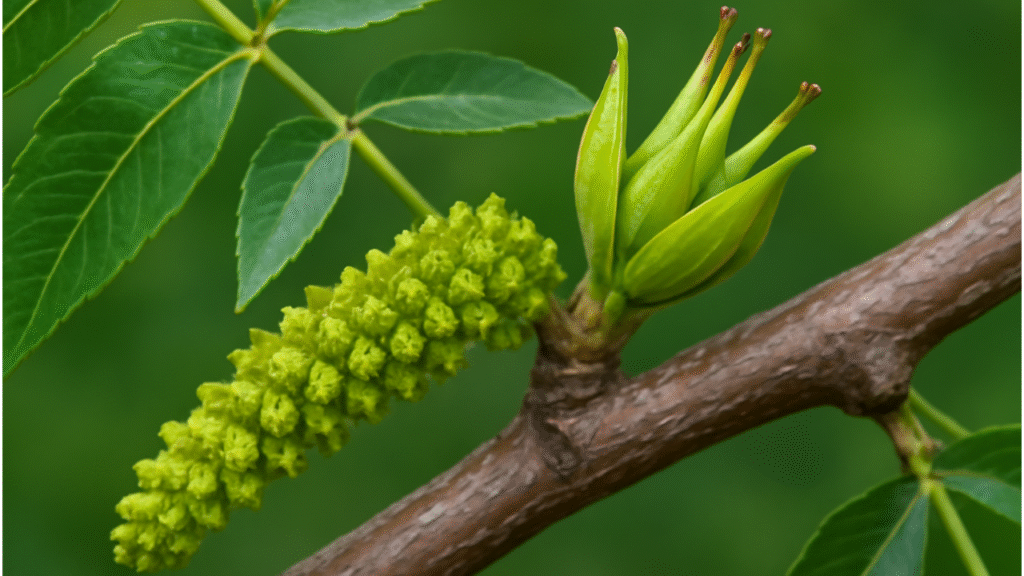
Everything You Need to Know About Pecan Tree Flowers: Identification, Pollination, and Growth Tips
Have you ever looked at your pecan tree and wondered, “Are these flowers doing their job?” 🌳 Pecan tree flowers might seem small and unremarkable at first glance, but they hold the key to your tree’s health and future nut production. If you’re eager to grow a thriving pecan tree and enjoy a bountiful harvest, understanding these flowers is essential.
In this guide, you’ll learn everything you need to know about pecan tree flowers: how to identify them, the vital role they play in pollination, and tips for ensuring your tree grows strong and produces high-quality pecans. Whether you’re a beginner gardener or an experienced grower, this article is packed with practical, actionable insights that will help you troubleshoot common problems and optimize your pecan tree’s performance.
Ready to unlock the secrets of successful pecan tree growth? Let’s dive in! 🌰
Table of Contents
Toggle🍃 Understanding Pecan Tree Flowers 🍃
Pecan tree flowers are the unsung heroes of your tree’s growth and nut production. While they may seem small and easy to overlook, they’re actually crucial to the entire process of growing healthy, productive pecan trees. Let’s break down what these flowers are, how they function, and why they matter so much. 🌟
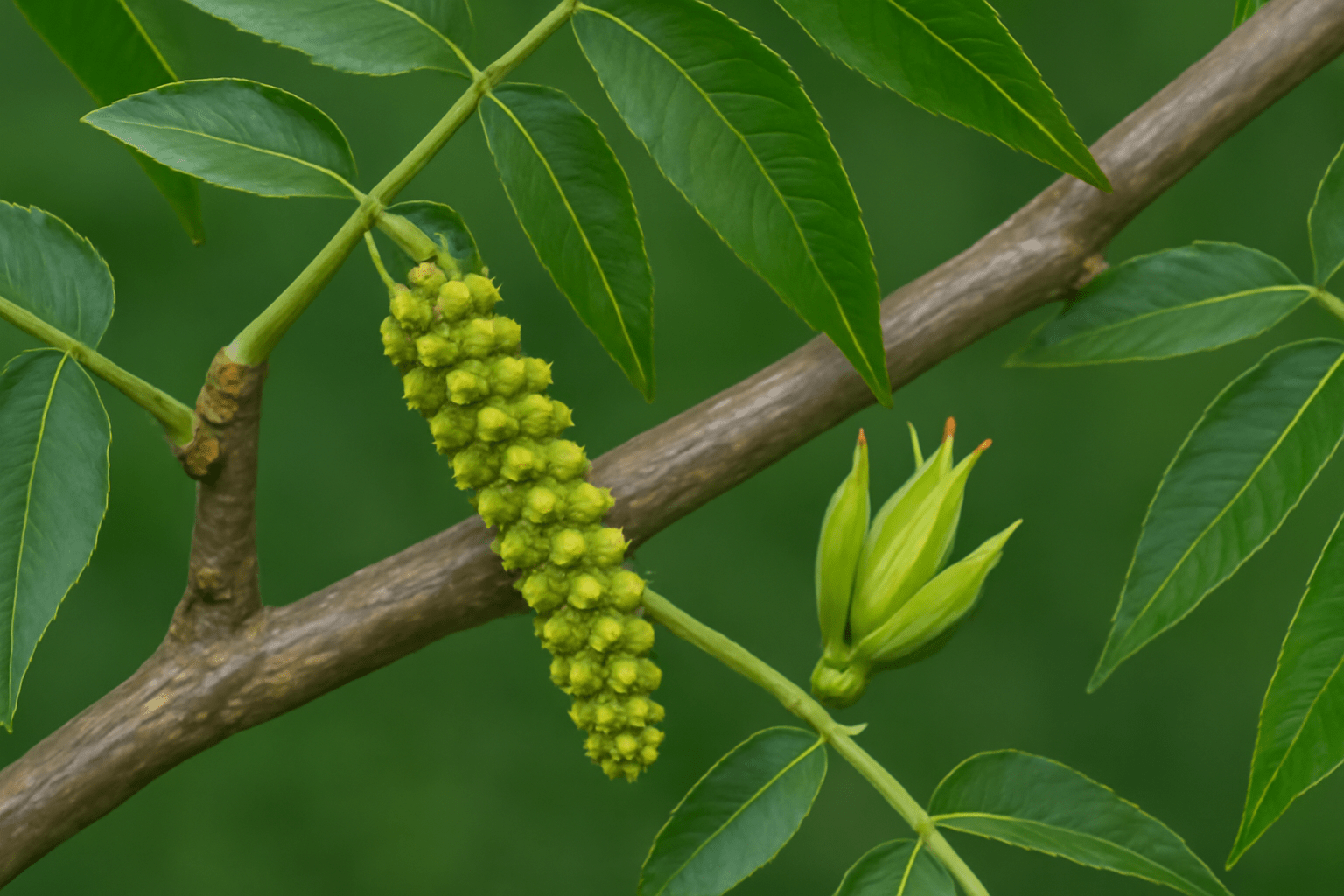
🌺 What Are Pecan Tree Flowers? 🌺
Simply put, pecan tree flowers are the reproductive organs of the tree, responsible for producing the next generation of pecans. 🌰 Pecan trees are monoecious, meaning they have both male and female flowers on the same tree, but in different locations. 🌿
🌿 Male Flowers (Catkins) 🌿
These are long, dangling clusters of tiny flowers that release pollen into the air. 🌬️ You’ll typically see them first in late winter or early spring. 🌸 These flowers don’t produce nuts, but they are vital for fertilizing the female flowers. 🌱
🌸 Female Flowers (Pistillate Flowers) 🌸
These are much smaller and harder to notice at first. 👀 Female flowers grow at the tips of the tree’s new growth, and their job is to catch the pollen released by the male flowers. 🍃 If pollination is successful, these flowers develop into pecans! 🌰
🌼 The Role of Pecan Tree Flowers 🌼
Pecan tree flowers are essential for the tree’s reproduction. 🌳 Without them, there’s no pollination, and without pollination, there are no pecans! 🥜 Here’s how the process works: 🌿
🍃 Pollination 🍃
The male flowers release pollen, which the wind carries to the female flowers. 🌬️ Successful pollination is key to the formation of nuts. 🌰
🌰 Nut Development 🌰
After pollination, the female flowers begin to develop into small, green pecans that will eventually grow and ripen. 🌟
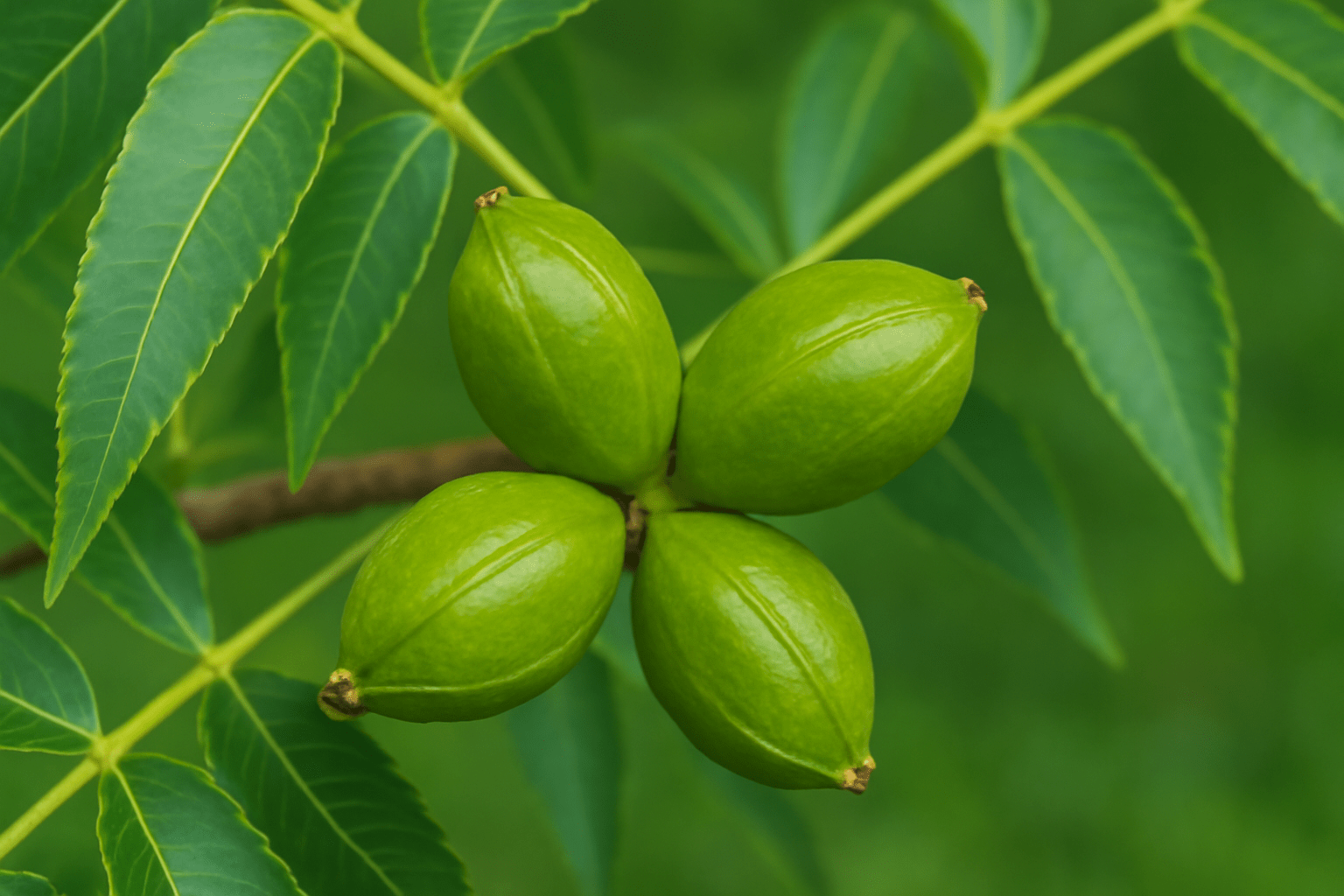
🕰️ Flowering Timeline: When Do Pecan Tree Flowers Appear? 🕰️
Knowing when pecan tree flowers bloom can help you plan for their care. 🌷 Most pecan trees flower in late winter to early spring, depending on the climate. 🌤️ You might see the first signs of male flowers (catkins) as early as February in warmer climates, with female flowers following shortly after. 🌞
However, flowering times can vary depending on several factors: 🌳
🌳 Tree age 🌳
Younger trees may not flower as abundantly. 🌱
🌡️ Climate 🌡️
Mild winters lead to earlier flowering, while colder areas see later blooms. ❄️
🌿 Variety 🌿
Different pecan tree varieties may bloom at slightly different times. 🌸
🌟 Why Understanding Pecan Tree Flowers Matters 🌟
Knowing how to identify and understand pecan tree flowers will help you care for your tree properly and ensure a better harvest. 🌰 If you can spot any issues with the flowers—like a lack of male flowers or poor female flower development—you can take action early to improve pollination and growth. 🌱
By being aware of the flowering process, you can also improve your chances of healthy pollination and, ultimately, a successful nut harvest. 🌰 Plus, caring for these flowers properly means healthier trees that thrive year after year. 🌳
So, now that you understand the basics of pecan tree flowers, you’re ready to dive deeper into pollination and growth tips! 🌿 Let’s keep going. 🌰
🌸 Identifying Pecan Tree Flowers 🌸
Identifying pecan tree flowers can be tricky, especially for beginners. 🌱 However, knowing how to spot them early on is crucial for ensuring proper pollination and a healthy tree. 🌳 In this section, we’ll show you how to easily distinguish male and female flowers and recognize the signs of healthy pecan blossoms. 🌰 Ready to become an expert in identifying pecan flowers? Let’s dive in! 🌿
🌿 Male Pecan Tree Flowers (Catkins) 🌿
The male flowers, also known as catkins, are the first to appear in the spring. 🌼 They are long, dangling clusters that release pollen into the air. Here’s what to look for: 👀
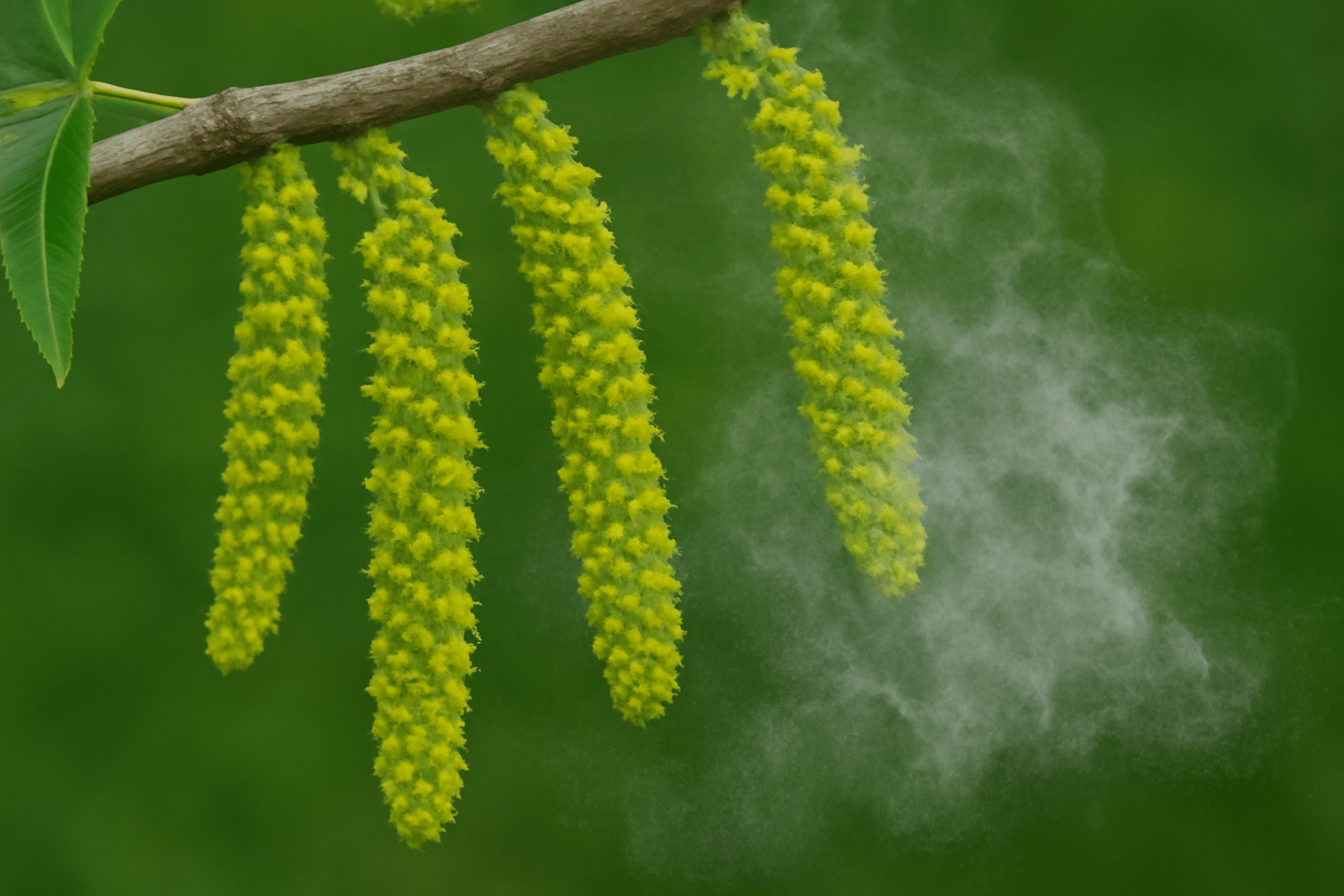
🌱 Shape & Size:
Male flowers are typically long and cylindrical, hanging down from the tree in clusters that look like small, greenish-brown tassels. 🌾
🌳 Location:
You’ll often find them on the older branches or new growth, especially on mature pecan trees. 🌳 These flowers can hang 4-6 inches in length. 🌟
🍃 Function:
Their sole purpose is to release pollen into the air, which will be carried by the wind to pollinate the female flowers. 🌬️
📝 Tip:
If you see long, hanging flower clusters early in the spring, you’ve probably found the male catkins! 🌬️
🌿 Female Pecan Tree Flowers (Pistillate Flowers) 🌿
The female flowers are much smaller and harder to spot. 🌸 They are also crucial for producing pecans, but they don’t resemble typical flowers you might expect. Here’s how to identify them: 👀

🌱 Shape & Size:
Female flowers are tiny, usually appearing as small, green, and sticky structures that are less than half an inch in size. 🌿
🌳 Location:
Female flowers typically grow at the tips of new shoots or the ends of the branches. 🌳 They look like little buds, almost invisible at first. 🌸
🍃 Function:
These flowers are where the pecans will develop after successful pollination. 🌰 Once pollinated, the female flowers start to form small, green nuts. 🌱
📝 Tip:
Female flowers may appear like tiny buds or even small, sticky spikes at the end of the branches. 🌺 They are often hard to spot unless you know where to look! 👀
🌸 Signs of Healthy Pecan Tree Flowers 🌸
When your pecan tree flowers are healthy, they’ll show certain characteristics. 🌱 Here’s how to tell if your flowers are thriving: 🌿
🌿 Male Flowers (Catkins):
Should be plentiful and visibly hanging from branches. 🌿 They should be a healthy green color with no signs of wilting or browning. 🌱
🌸 Female Flowers:
Should be visible at the tips of the branches, sticky to the touch, and free of discoloration. 🌸 If you see some tiny, green nuts starting to form, that’s a good sign of successful pollination! 🌰
📝 Tip:
Healthy male flowers produce abundant pollen, and healthy female flowers are sticky, ready to catch that pollen. 🌼
❌ Common Flower Problems to Watch For ❌
While pecan tree flowers are generally hardy, sometimes they can face problems that affect growth and pollination. 🌿 Here are a few common issues to watch out for: 👀
🚫 No Male Flowers (Catkins):
If you don’t see any male flowers on your tree, it could be a sign of poor tree health or an issue with the growing environment (like lack of sunlight). 🌞
🚫 Poor Female Flower Development:
Female flowers that don’t develop or turn brown quickly might indicate pollination problems, nutrient deficiencies, or environmental stress. 🌿
🚫 Early Wilting or Drooping:
If flowers begin to wilt early or droop significantly, this could be a sign of stress from pests, disease, or extreme weather. 🌧️
📝 Tip:
Regularly inspect your tree to spot these issues early and take steps to address them! 🌱
🌟 Quick Recap: How to Identify Pecan Tree Flowers 🌟
🌿 Male Flowers (Catkins):
Long, hanging clusters on older branches; release pollen. 🌬️
🌸 Female Flowers:
Small, sticky structures at the tips of new branches; develop into nuts after pollination. 🌰
🌼 Signs of Healthy Flowers:
Green, firm catkins and sticky, developing female flowers. 🌿 Look for tiny pecans starting to form! 🌰
By learning how to identify pecan tree flowers, you’re one step closer to ensuring your tree gets the right care and pollination it needs to thrive. 🌿 So keep an eye out for those catkins and sticky female flowers, and you’ll be well on your way to a bountiful harvest! 🌰
🌬️ Pollination of Pecan Tree Flowers 🌬️
Pollination is the magic that transforms pecan tree flowers into the delicious pecans you’re hoping to harvest! 🌰 Understanding how pollination works is essential for ensuring your tree thrives and produces a bountiful crop. 🌳 In this section, we’ll explain the pollination process, why it’s important, and how you can improve it to get the best results for your pecan trees. Ready to dive into the wind-powered world of pecan tree pollination? Let’s go! 🌿

🌟 Why Pollination Matters for Pecan Trees 🌟
Pollination is crucial because it’s the step that leads to the formation of nuts. 🌰 Without it, the female flowers on your pecan tree won’t develop into nuts, and your harvest will be nonexistent. ❌ But don’t worry—pecan tree pollination is easier than it sounds, thanks to the wind! 🌬️
🌿 Male Flowers:
The male flowers (catkins) release large quantities of pollen. 🌿
🌸 Female Flowers:
The female flowers catch this pollen, which fertilizes them and leads to the formation of pecans. 🌰
🌿 The Pecan Tree Pollination Process 🌿
Here’s a simple breakdown of how pollination works for pecan tree flowers: 🌱
🌬️ Male Catkins Release Pollen:
The male flowers produce pollen that is carried by the wind. 🌬️
🍃 Wind Carries Pollen to Female Flowers:
Since pecan trees are wind-pollinated, the pollen is transported to female flowers on other parts of the tree or nearby trees. 🌿
🌸 Female Flowers Receive Pollen:
The pollen lands on the sticky, receptive female flowers, where fertilization takes place. 🌼
🌰 Nut Development:
Once pollinated, the female flowers develop into small, green pecans that will grow and mature throughout the season. 🌳
📝 Tip:
Pollination typically happens early in the spring, but the process can vary depending on weather conditions and tree health. 🌱
🌬️ Wind Pollination: The Role of the Breeze 🌬️
Pecan trees are primarily wind-pollinated, which means they don’t need bees or other insects to carry the pollen. 🐝 Instead, the wind does the job. 🌬️ Here’s how to optimize wind pollination for the best results:
🌬️ The Right Amount of Wind:
A gentle breeze is ideal. 🌬️ Too much wind can blow the pollen away before it reaches the female flowers, while too little wind can slow down the pollination process. 🌿
🌞 Pollination Timing:
Male flowers release pollen during the early spring when wind conditions are usually favorable. 🌤️ However, if you notice a lack of wind or rainy conditions, it may reduce the effectiveness of pollination. 🌧️
📝 Tip:
If you’re planting pecan trees in a windy area, you’ve got a natural advantage when it comes to pollination! 🌬️
🌳 How to Improve Pecan Tree Pollination 🌳
Even though pecan trees rely on wind pollination, there are a few strategies you can use to improve your chances of successful pollination and maximize your nut production. 🌰
🌿 Plant Multiple Trees:
To ensure successful cross-pollination, it’s a good idea to plant at least two different pecan tree varieties. 🌳 Having a variety of trees nearby increases the likelihood of pollen reaching the female flowers and enhances overall pollination. 🌱
🏠 Avoid Wind Barriers:
Make sure that there are no barriers, like large buildings or dense hedges, blocking the flow of pollen between trees. 🏡 A clear, open space helps the wind carry pollen effectively. 🌬️
🌳 Space Trees Properly:
Proper spacing between trees allows pollen to travel easily from male flowers to female flowers. 🌿 Make sure trees are planted at least 30-50 feet apart for optimal pollination. 🌸
🌱 Ensure Healthy Tree Growth:
Strong, healthy trees will produce more pollen and more female flowers, increasing the chances of successful pollination. 🌳 Regular care, proper watering, and good soil health all contribute to better pollination outcomes. 🌿
📝 Tip:
The more pecan trees you have in your yard or orchard, the higher the likelihood that you’ll get a great pollination process! 🌳
❓ What Can Go Wrong with Pecan Tree Pollination? ❓
While pollination is largely a natural process, there are a few common issues that can affect it. 🌿 Here are some problems to watch out for: 👀
🚫 Poor Wind Conditions:
If there is little to no wind during the flowering period, pollen may not reach the female flowers, leading to poor pollination. 🌬️
🚫 Lack of Male Flowers:
Without enough male flowers (catkins), there won’t be enough pollen to fertilize the female flowers. 🌸
🚫 Inadequate Tree Spacing:
If trees are too far apart, pollen may have a harder time reaching the female flowers. 🌱 Trees that are too close together might also hinder air circulation and reduce pollination success. 🌿
📝 Tip:
Regularly inspect your trees to ensure that they’re flowering at the right time and in the right conditions to encourage proper pollination! 🕵️♂️
🌟 Quick Recap: Pollination Essentials 🌟
🌬️ Pollination Process:
Wind carries pollen from male flowers (catkins) to female flowers, resulting in the formation of pecans. 🌰
🌿 Optimizing Pollination:
Plant multiple trees, ensure proper spacing, and avoid wind barriers to boost pollination success. 🌳
🚫 Common Issues:
Poor wind conditions, insufficient male flowers, and improper tree spacing can hinder pollination. 🍃
By understanding and improving the pollination process, you can set your pecan trees up for success. 🌳 So, make sure to monitor the weather, plant more than one tree, and enjoy the results of your efforts when your pecan tree starts to develop those little green nuts! 🌰
🌱 Growth Tips for Pecan Trees Post-Flowering 🌱
After your pecan tree flowers have bloomed and pollination is successful, the next step is to ensure that your tree continues to thrive and develop healthy, delicious pecans. 🌰 This phase requires attention to detail and proper care to ensure that the flowers turn into fully-formed nuts. 🌿 In this section, we’ll walk you through the best growth tips for pecan trees after flowering, covering everything from watering to pest control. Let’s get started! 🌳
🌿 What Happens After Pollination? 🌿
Once your pecan tree has been successfully pollinated, the female flowers will begin to transform into small, green pecans. 🍃 This process takes time and requires the right care. Here’s what happens next:
🌰 Nut Development:
After pollination, the fertilized female flowers begin to swell and develop into small, green pecans. 🌱
🌿 Growth Stage:
Over the next several months, the nuts will grow larger and begin to mature, eventually changing color and becoming ready for harvest in late summer or early fall. 🍂
💧 Watering Your Pecan Tree After Flowering 💧
Watering is a critical factor for healthy pecan tree growth, especially after the flowering period when the nuts begin to develop. 🌳 Here’s how to keep your tree hydrated:
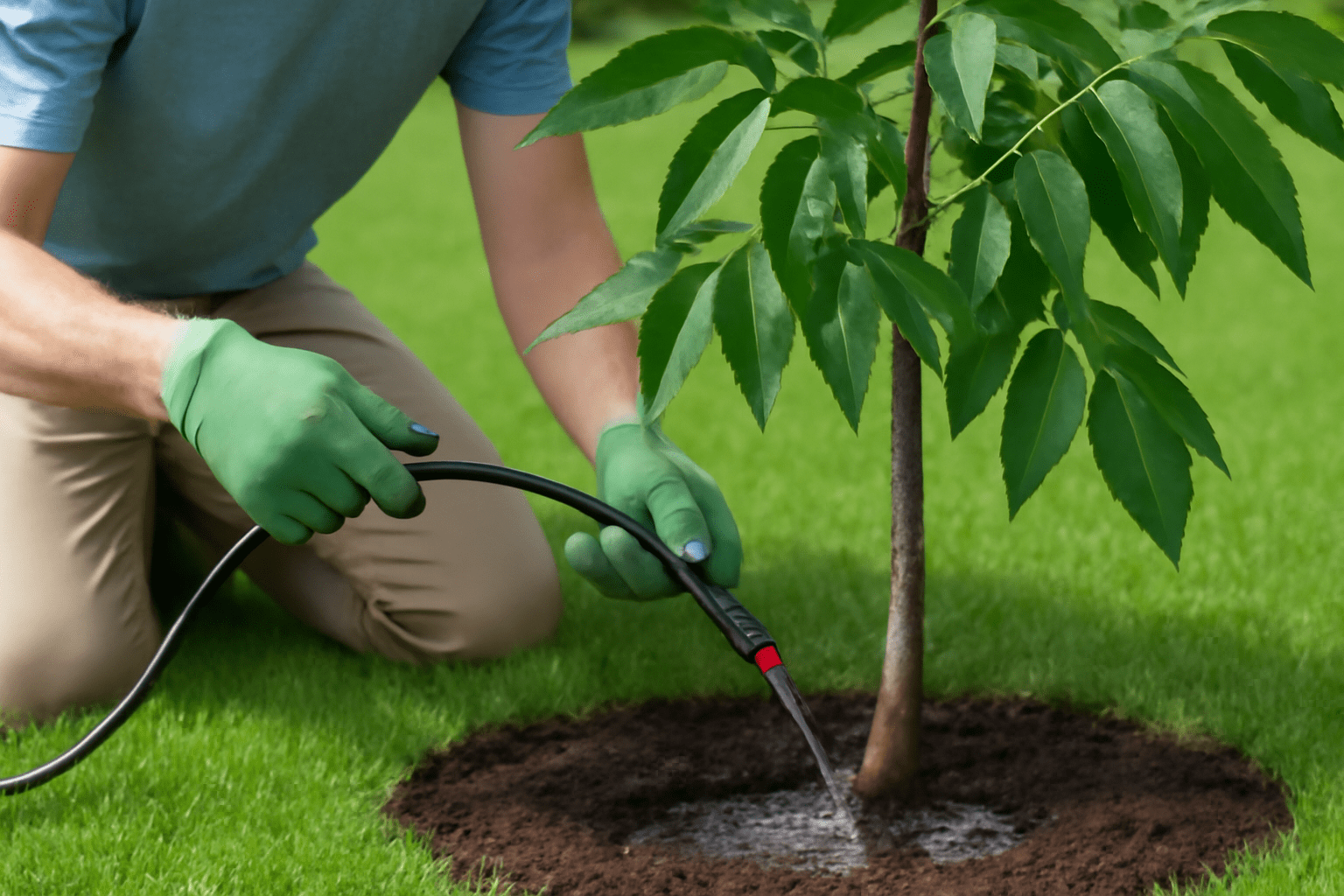
🌿 Deep Watering:
Pecan trees need deep watering to ensure the roots get enough moisture. 🌊 Water the tree deeply once or twice a week, depending on weather conditions. 🌞
🚫 Avoid Overwatering:
While pecan trees love water, too much can lead to root rot. 💧 Make sure the soil drains well to prevent water from sitting around the roots. 🌱
🌞 Drought Stress:
In dry periods, pecan trees are especially vulnerable. Lack of water can lead to poor nut development and premature nut drop. 🌾
📝 Tip:
Use a drip irrigation system to provide a slow, steady water supply directly to the tree’s roots. 💦
🌿 Fertilizing Pecan Trees After Flowering 🌿
Proper fertilization helps your tree grow strong and healthy, supporting the development of large, quality nuts. 🌰 Here’s how to fertilize your pecan tree after flowering:
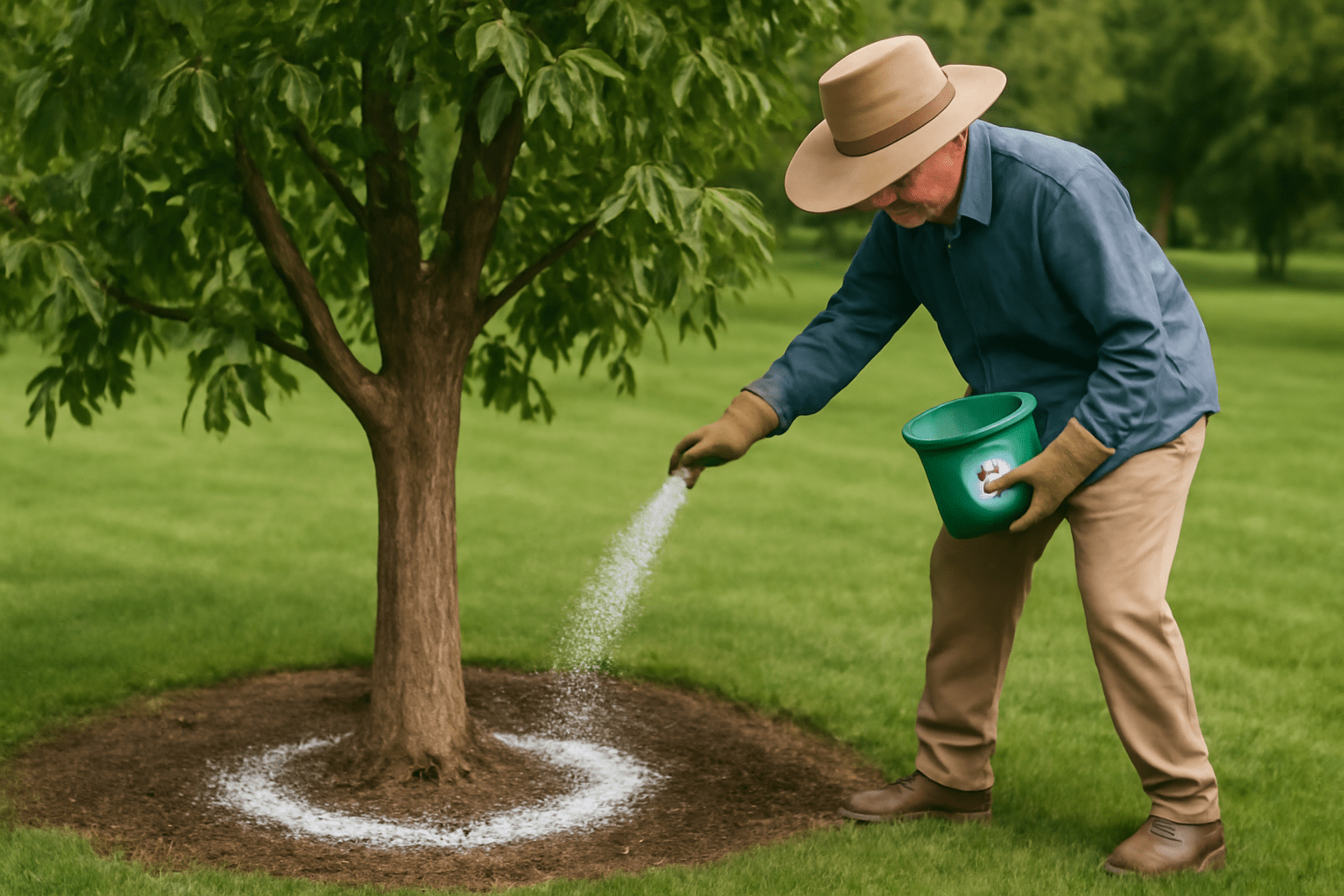
🌱 Balanced Fertilizer:
Use a balanced fertilizer with equal parts nitrogen, phosphorus, and potassium. 🧪 Nitrogen helps the tree grow, while phosphorus and potassium are essential for nut development. 🌿
🌸 Timing:
Apply fertilizer in early spring before the tree flowers and again after flowering, when the nuts are starting to form. 📅 Be sure to follow the manufacturer’s instructions on the fertilizer package. 🌿
🌳 Organic Options:
Compost and well-aged manure can also provide slow-release nutrients to support healthy growth. 🌿
📝 Tip:
Over-fertilizing can harm your tree, so always follow the recommended application rates. 🌱
✂️ Pruning and Maintenance ✂️
While pecan trees don’t require heavy pruning, proper maintenance is important for ensuring they grow healthily after flowering. 🌳 Here’s what you need to know:
🌿 Light Pruning:
In the summer, remove dead or damaged branches to keep the tree healthy. 🌳 Light pruning can also help improve air circulation and sunlight penetration, both of which are important for healthy nut development. 🌞
🚫 Avoid Heavy Pruning:
Don’t prune too much after flowering, as this could stress the tree and affect nut production. 🍂 Focus on maintaining the tree’s shape rather than cutting back large portions. 🌳
📝 Tip:
Always prune pecan trees when they are dormant (late winter or early spring) to minimize the risk of damaging new growth. 🌱
🐜 Pest and Disease Control 🐜
Your pecan tree is now in the critical nut-growing stage, so protecting it from pests and diseases is key to a successful harvest. 🐞 Here are some tips for pest and disease management:
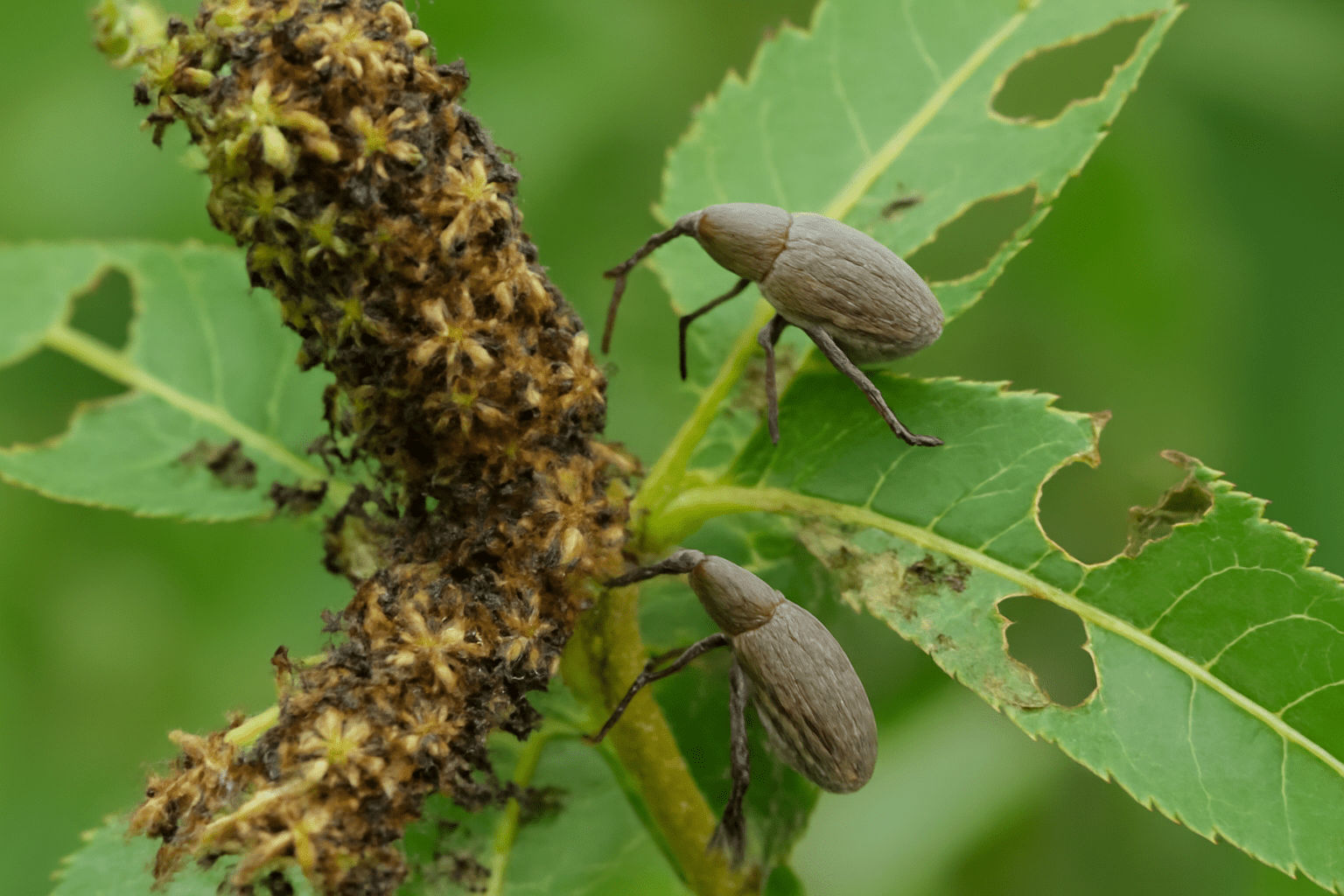
🐞 Common Pests:
Keep an eye out for common pests like aphids, pecan weevils, and caterpillars. 🐛 These pests can damage the flowers, leaves, and developing nuts. 🌱
🛡️ Solution:
Use organic insecticides or introduce natural predators like ladybugs 🦋 to control pests. 🌿
🍂 Disease Prevention:
Pecan trees are susceptible to fungal diseases like scab and leaf spot. 🍂 To prevent these:
🛡️ Solution:
Apply fungicides during the growing season and remove any affected leaves or branches promptly. 🍃
📝 Tip:
Regularly inspect your tree for pests and diseases, especially during the nut-growing season, to prevent problems from escalating. 🐞
🌞 Ensure Proper Sunlight 🌞
Pecan trees need plenty of sunlight to grow and develop nuts successfully. 🌳 After flowering, make sure your tree is getting enough sun:

🌞 Full Sun:
Aim for at least 6-8 hours of direct sunlight per day. 🌅
🌳 Tree Placement:
If you’ve planted your tree in a shaded area, consider trimming back any nearby foliage or structures that may be blocking sunlight. 🌿
📝 Tip:
Pecan trees that receive full sun are healthier and produce better nuts, so place them in a location with maximum exposure to sunlight. 🌞
🚜 Harvesting and Beyond 🚜
Once the pecans have fully developed, the next step is harvesting. 🌰 Here’s a quick tip to know when to pick your pecans:

🕰️ Timing:
Pecan nuts are ready for harvest when the outer husk begins to split, revealing the brown shell inside. This typically happens in late summer or early fall, depending on the climate. 🌞
🌰 Harvesting:
Gently shake the tree to release the mature nuts, or hand-pick them if necessary. 🌿
📝 Tip:
Be patient—pecans can take several months to fully ripen, and harvesting too early can affect their flavor and texture. 🌰
🌟 Quick Recap: Growth Tips After Flowering 🌟
💧 Watering:
Deeply water the tree but avoid overwatering. 💦
🌱 Fertilization:
Use balanced fertilizer and apply after flowering to support nut development. 🌿
✂️ Pruning:
Lightly prune dead or damaged branches and avoid heavy pruning after flowering. 🌳
🐞 Pest & Disease Control:
Monitor for pests like aphids and pecan weevils and use appropriate treatments. 🐜
🌞 Sunlight:
Ensure your tree gets 6-8 hours of direct sunlight per day. 🌞
🚜 Harvesting:
Wait until the husks begin to split before harvesting. 🌰
By following these tips, you’ll be well on your way to growing a healthy, productive pecan tree that produces delicious nuts year after year! 🌳🌰
🌟 Final Thoughts 🌟
Growing a healthy and productive pecan tree takes patience, knowledge, and the right care at each stage of growth—from flowering all the way to harvesting. 🌳 By understanding pecan tree flowers, their role in pollination, and how to nurture your tree after the flowers bloom, you set yourself up for a bountiful harvest of tasty, homegrown pecans. 🌰
Remember, it all starts with identifying those vital flowers and ensuring they get the attention they deserve. 🌸 Whether it’s improving pollination, watering your tree properly, or protecting it from pests, every step you take will help your tree grow stronger and produce better nuts. 🌿

So, take the time to apply these tips and techniques, and you’ll be rewarded with a thriving pecan tree that will bring joy to your garden and delicious pecans to your kitchen for years to come! 🌳
Happy gardening, and here’s to your next great harvest! 🌱🌰
🤔 Frequently Asked Questions (FAQs) 🤔
When do pecan tree flowers bloom?
Pecan tree flowers usually bloom in late winter to early spring, depending on your climate. Male flowers (catkins) typically appear first, followed by female flowers. In warmer climates, you might see flowers as early as February, while cooler areas may experience later blooming.
How can I tell if my pecan tree flowers are pollinated?
You’ll know your pecan tree flowers are pollinated when the female flowers start developing into small, green pecans. If the flowers don’t produce nuts or look dried up, the pollination process might have failed.
Can I hand-pollinate my pecan tree flowers?
Yes, you can hand-pollinate your pecan tree flowers using a small paintbrush to transfer pollen from male catkins to female flowers. However, since pecan trees are primarily wind-pollinated, hand-pollination is usually only necessary in areas with poor wind conditions.
Why isn’t my pecan tree flowering?
There are several reasons why your pecan tree may not be flowering: it could be too young, experiencing stress from poor soil or improper watering, or in an area with insufficient sunlight. Additionally, extreme weather or improper pruning can delay or prevent flowering.
How do I identify male and female pecan tree flowers?
Male flowers (catkins) are long, hanging clusters that release pollen, while female flowers are smaller and appear as sticky, tiny spikes at the ends of branches. Female flowers are less noticeable and often require a closer look to spot.
How can I improve pollination for my pecan tree?
To improve pollination, plant at least two different pecan tree varieties to encourage cross-pollination. Ensure proper spacing (30-50 feet apart) between trees and avoid wind barriers. Healthy trees with abundant male and female flowers also enhance pollination success.
How often should I water my pecan tree after flowering?
Water your pecan tree deeply once or twice a week during dry periods to support nut development. Be careful not to overwater, as this can lead to root rot. The soil should be moist but not soggy.
When is the best time to harvest pecans?
Pecans are ready to harvest when the outer husk starts splitting open, revealing the brown shell inside. This usually happens in late summer to early fall. Keep an eye on the trees, and harvest when the nuts naturally fall or when the husk easily separates from the shell.
